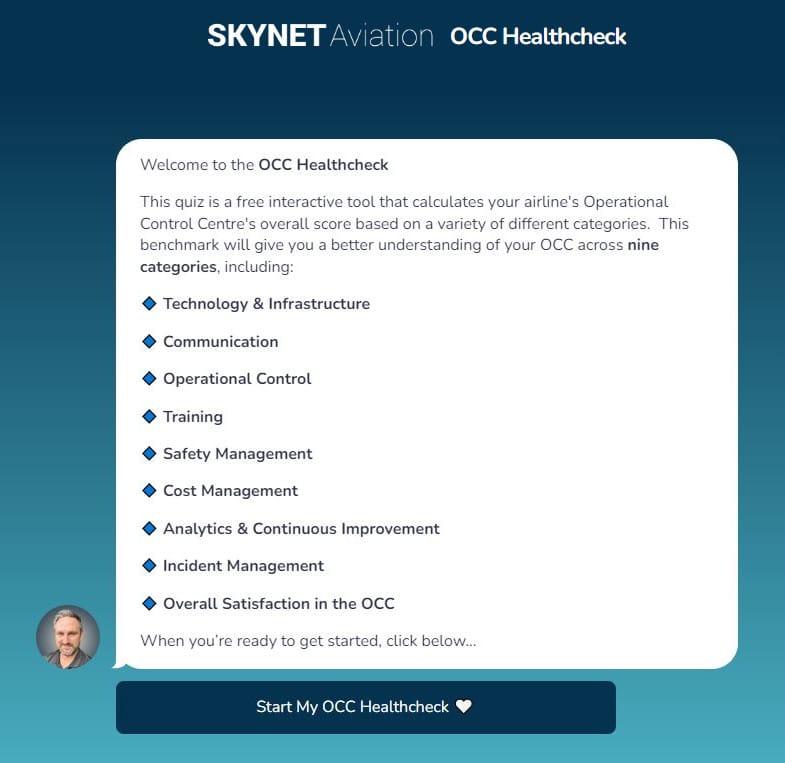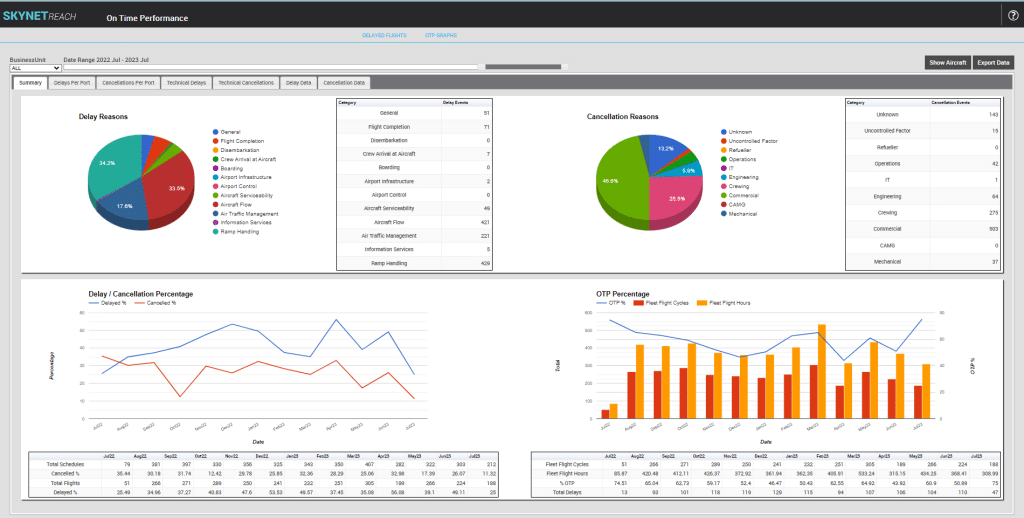Change doesn’t have to come at the cost of complexity.
An airline’s Operations Control Centre (OCC) is the epicentre for organisational change in an industry with tight financial margins and even tighter margins for risk. Effects will ripple outward, impacting all areas of your business.

If you’re embedded in the Ops team of a small-to-medium airline, SkyNet’s new OCC Health Check suggests that you’re in the vast majority should you already see scope to do things better. Experience says you are also likely subject to a daily barrage of cross-business inputs and time-critical demands that see you working in the business and not on it.
How do you think your OCC is going? What challenges are you facing? What’s changing externally that could impact Ops? What is your strategic focus and what do you need to achieve it? Comment or reach out.
Benchmarking in diverse aviation sectors
The ecosystem within each Aviation Operations Control Centre varies greatly, but KPIs and general areas of responsibility remain relatively constant globally. Technology and processes to meet KPIs can depend on factors from fleet size, fleet mix, and service delivery model, to inherited technology or solutions that have been used to a degree of success. Most are supported with a scaffolding of spreadsheets, group emails and pure human diligence.
But you see potential for it to be different.
10 minutes to pinpoint where your OCC can make the biggest wins
We’re almost into June. Time flies, particularly in a busy OCC. Paul Chevalier, GM at SkyNet knows this firsthand, having an Ops background that includes WestJet, Virgin Australia, and software implementation projects. Acknowledging both lack of time, and performance benefits of periodic reviews is the motivation behind SkyNet’s OCC Health Check. Paul designed the tool as a 10-minute high-level self-assessment of key functionalities. The final score provides a benchmark to encourage conversations that foster continuous improvement. You can complete it anonymously or enter details post-completion with assured confidentiality.
The health check addresses 9 areas, with scores weighted based on their operational impact. Whilst it doesn’t delve too deeply into trade-sensitive information, it does point to gaps between current state and desired state.

With key areas identified, the next step is to ask questions. Can you deliver a better service through automation? How can you equip your Ops team to focus on more impactful activities? How can you pursue growth without requiring an in-line resource increase, and in doing so, advance viability? Can reporting and compliance data be produced more accurately and efficiently and presented in a more accessible, timely and relevant format? Are risks minimised and if something doesn’t go right, are you recovering as quickly, safely, and cost-effectively as possible?
Taking in the full view
A full view involves considering external factors that could impact your Operations Control Centre. Of those you can bring within your control, technology is key.
“It’s valuable to have the OCC Health Check insights when you investigate further technology integration so that decisions are made in line with a greater strategy”. Paul explains that clients don’t want more technology, they want less, that does more and meets their specific needs. Any new tool mustn’t come with excess administrative baggage. Current tools cannot, and sometimes need not, just be dropped. Further, changes to systems and processes must be accompanied by a strong business case and a clear path forward in terms of organisation-wide adoption.
For too many, their current OCC tech stack is the oversized solutions of large commercial airlines, or a cobbling together of multiple individual products that don’t support efficiency, growth, or people. Each new addition of ‘help’ adds another layer of complexity.
It doesn’t need to be this way, and the solution doesn’t need to turn the ripple effect into shockwaves.
The ultimate OCC destination
Adopting the right technology and processes can have a profound impact, particularly for small to medium-sized airlines (SMA) where upside can be observed much faster.
“The services and integrations we provide deliver a functional flow of information between multiple systems, the operational ease of an all-in-one control panel, and usable data that can only result from pulling together multiple elements into a robust management tool.”
What does that control panel look like for actual clients? “It’s efficient, low cost, easy to use scheduling, planning, and real-time flight tracking presented cohesively in one place. It allows a team to achieve more while reducing exposure to inconsistencies, human error, and oversights” says Paul of the core purpose.
“An everyday example is an Ops team not needing to leave our system to make alterations to crewing or flight planning, with information flowing through to 3rd party products. Tail, gate, and schedule changes flow throughout the tech ecosystem and are communicated to their crew, ground handlers and charter clients. The same client’s pilot may enter fuel data in ForeFlight or Jeppesen Dispatch, our system captures this in real-time, and it’s included in automated messages set up for refuellers who can even receive notifications triggered by certain events such as our tracking indicating 20 minutes to aircraft arrival. Likewise, passenger numbers in an integrated reservations system being automatically forwarded to caterers.” Seamless integration supports your SMS and frees the Ops team. The ability to personalise automated consistent communication is proven effective in strengthening relationships.
‘Although the goal is generally to minimise the number of products our clients must use and pay for, this same 3rd party integration capability works seamlessly with a myriad of products, be it in a transition or ongoing phase.” The nature of the control panel embraces identified business needs and allows data to be pulled from multiple sources for accurate reporting that is accessible to appropriate people across an organisation. Different access levels are possible per employee, and even per client for those who want to offer their long-term clients their own FIDs board. “The data holds weight and is a far better basis for critical decision-making because it has integrity, is accurate, available when needed, and doesn’t require all staff to be highly adept with all operating tech components”.
Changing the course of an entire airline operation
As the name suggests, the Operations Control Centre is central to the entire aviation entity and change effected here will impact other departments. This, and the busyness of an Ops team functioning in a climate of industry recovery, staff and skill shortages, higher-than-ever client expectations, and economic belt-tightening, combine to be both catalyst and impediment to growth and development traction.
Paul’s team take a personalised approach based on an uncomplicated needs analysis, allowing an SMA to make gains across all areas addressed in the OCC Health Check. The change involved doesn’t need to be dramatic to produce dramatic improvements. It can be staged and is supported by multiple levels of client services.
Such a hands-on approach, generous training investment, and willingness to work with you on your OCC are not what you’d normally expect in tech.
Paul is passionate when he explains, “We are first and foremost in this industry because we love it. Passion for aviation and the success of our clients is what drives us. Our product offering is at the leading edge, and we are happy to be behind the scenes of incredible projects worldwide. At the same time, we are privately owned and have grown organically to support clients that we still serve after 20+ years. This has happened because enabling the success of our clients is behind innovation, it’s purposeful and not innovation for innovation’s sake.”
10 minutes can start you on the journey to saving 200 minutes a day
SkyNet’s OCC Health Check takes around 10 minutes to complete. The client referred to earlier will be featured in future case studies. They have been with SkyNet for some time and are introducing further control panel automation and integrations that extract maximum benefit from their entire suite of tech tools. With an OCC team overseeing a fleet of 8-12 aircraft, they can expect a reduction of time spent on OCC administrative, accounting, and reporting tasks by 200 minutes per day of operation. Recovery expenses will fall dramatically. Customer experience benefits. The upsides travel out to deliver an even safer, more reliable, more financially viable, and more culturally healthy operation.
When assessing where your OCC is and where you’d like to take it, SkyNet invites you to leave your details or reach out directly. A needs-based discussion could be the start of an OCC-initiated development strategy that improves KPIs across your organisation and beyond.

About Paul
Paul Chevalier has an Ops background spanning WestJet, Virgin Australia, and Air Traffic Management. As GM of SkyNet Aviation, he is part of a team that develops and partners with the most current aviation technology solutions, successfully integrating them into client operations ranging from fixed and rotary-wing aviation specialists to RPT and charter airlines in Australia and internationally. Paul and the SkyNet team are also on standby as the solution for future large-scale eVTOL fleets capable of thousands of on-demand, and scheduled journeys daily.



